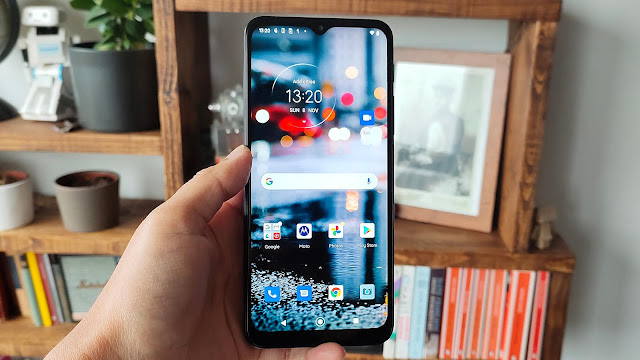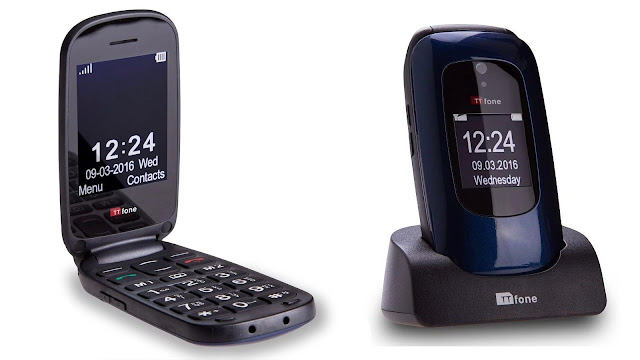Smartphones are incredibly popular devices but their immense capability has made them increasingly complex for novices. What might seem second nature to young people can be incredibly confusing to a generation that grew up before the internet.
Unfortunately, the vast majority of the market caters to experienced phone users, so you have to look a little deeper if you want a phone that’s truly appropriate for older generations. A smartphone might still be the way to go, but if calling and texting is still the priority then a basic mobile might be more appropriate.
Here we’ll look in detail and what a smartphone is, and how that affects usability. Then we’ll suggest some simple things to look for when buying a smartphone.
Here are a few handset recommendations, if you’re after any easy to use smartphones and feature phones.
Nokia 2720 Flip
- Classic flip phone design
- WhatsApp support
- Emergency button
Cons
- Price premium for form factor
- Lacklustre camera
The Nokia 2720 Flip is one of Nokia’s popular throwback phones, here resurrecting the iconic flip phone form factor. That means you’re paying a bit of a premium for the combo of nostalgia and novelty, but there’s an argument that it’s worth it.
It certainly helps that you still get a fairly modern feature set. There’s 4G support, along with some basic apps; meaning you can still use Google Maps, Facebook and (perhaps most importantly) WhatsApp. There’s even an app for Google Assistant, with a dedicated button to activate it or if you prefer you can set this up to serve as an emergency button, sending out a text to specified contacts in case anything goes wrong.
Nokia quotes a 28-day battery life, and while we haven’t quite tested it for that long, it’s clear that the 2720 will run for a while.
You also get Bluetooth, a headphone jack, a camera (though it’s admittedly a bit ropey) and 4GB of internal storage, with support for microSD cards up to 32GB.
Doro 8080
- Included charging cradle
- HAC (Hearing Aid Compatible)
- Assisted user experience
Cons
- Pricey considering hardware
- Disappointing cameras
- Speakerphone could be louder
Some companies have made the mistake of patronising their target market. Thankfully, Doro strikes the right balance and the 8080 is a phone that provides a helpfully-modified Android smartphone experience (dubbed ‘Eva’); letting you navigate around the user interface using your voice, with the help of the Google Assistant (if you so choose).
The 8080 features a 720p HD display, a 16Mp and 5Mp dual rear camera and comes with a dock for convenient charging and hands-free speakerphone use.
It also features Doro’s signature Response Button, which paired with a companion app, can be used to instant alert chosen contacts in an emergency, with a single press.
Moto G9 Play
- Affordable
- Superb battery life
- Clean Android user experience
Cons
- Plastic build
- Lacklustre cameras
- Dim display
Like the Doro 8080, the affordable Moto G9 Play runs Google’s Android software. The G9 Play is the one for you if you think you need less guidance from the phone as to how to make calls, send messages and download apps.
Android is fairly simple if you aren’t a heavy-duty user, and it shouldn’t be too much trouble if you’ve used a simple smartphone before. Its biggest strength is its huge 5000mAh battery, which offers exceptional longevity.
The display is expansive, at 6.5in but a little dim, while the price is hard to find fault with.
Read our full Moto G9 Play review
iPhone SE (2020)
- Great performance
- Decent main camera
- Long-term software support
Cons
- Dated design
- Lacklustre battery life
- Underwhelming display
The updated iPhone SE for 2020 doesn’t have the same compact nature as its predecessor but it instead delivers a larger display, easy-to-use hardware controls, great performance and a great camera.
It’s one of the most expensive entries in this list but it’ll undoubtedly last you, not to mention, it’s one of the best value-for-money phones Apple has ever released.
Read our full Apple iPhone SE (2020) review
TTfone Lunar TT750
- Highly affordable
- Great accessibility features
- Emergency button
Cons
- No 3G or up
- Buggy
- Tinny audio
The TTFone Lunar might not be the first phone that leaps to mind but the company has been making a name for itself in recent years with inexpensive products aimed primarily at the elderly and those with less than 20/20 vision.
This is borne out by the large print used on the keypad, making it easy to distinguish one from the other without needing a chunky handset and generous on-screen font size as standard. Accessibility features don’t end there, as the TT750 also boasts loud overall speaker volume to ensure that text messages and calls aren’t missed, plus a programmable SOS emergency button, which means the phone can double as an alert if the user has a fall or other accident.
The clamshell design makes the TT750 easy to fit into bags or pockets, and a desktop cradle dock removes the need to fiddle around with leads when you want to recharge the battery.
If you’re thinking of buying a phone for your elderly relative and want something easy-to-use, then the TT750 should be on your shopping list.
Alcatel 2019G
- Compact
- Easy to use
- 4G
- Lightweight
- Call quality
Cons
- Small display
- Weaker battery than predecessor
- Awkward charging
Alcatel has gone with a very traditional design for its easy-to-use 2019G phone. A smaller display makes way for a big button keypad.
It supports legacy T9 texting but will be most appropriate for a generation that relies on calls to stay in touch. Other features include an SOS button that, when pressed, will call several preset numbers systematically.
There’s even a 3.2Mp rear camera, which is capable of taking both stills and video.
What is a smartphone?
A smartphone is in essence a web-connected mobile phone. It has the ability to send and receive emails, browse the web, and download and run apps: applications optimised for the smaller touchscreen experience of a smartphone or tablet.
These offer easy access to things such as news, sports and weather information, as well as fun games with which to waste an idle hour. All smartphones also double as media players, letting you enjoy music, films and ebooks you already own, as well as being able to stream or download new content from dedicated stores, accessed directly from the smartphone. All smartphones work as compact cameras, too.
Smartphones have dedicated operating systems, with the vast majority of devices running either Apple’s iOS or Google’s Android. They have much larger screens than regular mobile phones (also known as basic phones or feature phones), usually in excess of six inches.
They connect to the internet via either cellular (3G/4G/5G etc.) or WiFi technology. Cellular technology requires a SIM card with a data allowance, which you have to pay for in the same way you pay for calls and text messages. But whenever you are in range of a wireless network (WiFi) for which you know the password (or doesn’t require one), you can switch to that and use data-based apps and features for free.
Basically, you can do on a smartphone anything you can do on a web-connected desktop computer/laptop. Some things – email, for instance – may actually be easier to do on a mobile device, although most of the time the smaller screen can mitigate against prolonged use.
What to look for
Now that you are (hopefully) sold on the benefits of joining the smartphone world, here are a few pointers as to what to look for. It’s always worth trying out a handset in-store, so you can get a feel for the hardware and the user interface (the way the phone’s software looks and feels to use). The breadth of choice can be off-putting, but don’t be afraid to take your time and try as many handsets as you like before making a choice: this is a purchase you’ll want to make only once every two to three years, so it pays to get it right.
A simple interface
Due to the massive amount of functionality smartphones offer over feature phones, they can seem complicated to use. Look for a smartphone with simple, easy to use, intuitive navigation. Think of a few key things you are going to want to do – make a call, send an email, find a phone number – and ask to try them out in the store. Don’t be afraid to ask for advice, but if it takes a sales assistant a long time to explain how to undertake such key tasks, that may not be the phone for you.
Make sure you spend some time using the onscreen keyboard, too. Most will respond to keypresses by making the letter or number concerned bigger, and even vibrating gently. This can be a huge aid when it comes to usability, but not all interfaces are built the same.
Apple products are famed for their ease of use, and the iPhone is generally a very simple and intuitive device to get to grips with. Choosing one does mean that you pay Apple’s prices though, which are typically higher than most alternatives.
Most smartphones on the market, however, use Google’s Android OS. Android phones offer greater variety and come in a wider array of shapes, sizes and prices. It’s important to note that different manufacturers may dress the underlying Android experience in their own ‘skin’ or ‘launcher’. Trying before you buy will help give a sense of how easy to use each manufacturer’s launcher is and whether it’s right for you.
If you find that a touchscreen interface is too difficult to use effectively (and studies have shown that issues with hand-eye coordination accompany ageing), it may be that a device that also comes with a hardware keyboard or supports a compatible accessory is the way to go.
A large screen
Virtually all smartphones have at least a 5.5in display, these days. High-end devices, such as the Android-based Samsung Galaxy S21, have displays that move past 6in.
The bigger the screen, the more expensive a phone tends to be (although not always) and a large screen will drain battery life slightly faster. It’s, also worth remembering that not all screens are created equal: the display on a relatively small device can be sharper than that of some larger phones. So once again, trying before buying is important.
Something easy to carry about
Simply because smartphones contain so many features, they have to include a big battery and a powerful processor. Add in the large screen and a smartphone can quickly become cumbersome in the eyes of some users. Again, this is where it is worth trying out a phone before you commit. The smartphone with the big screen may be easy to look at, but if it is too heavy to carry about it isn’t going to be of much use.






.jpg)


0 comments:
Post a Comment